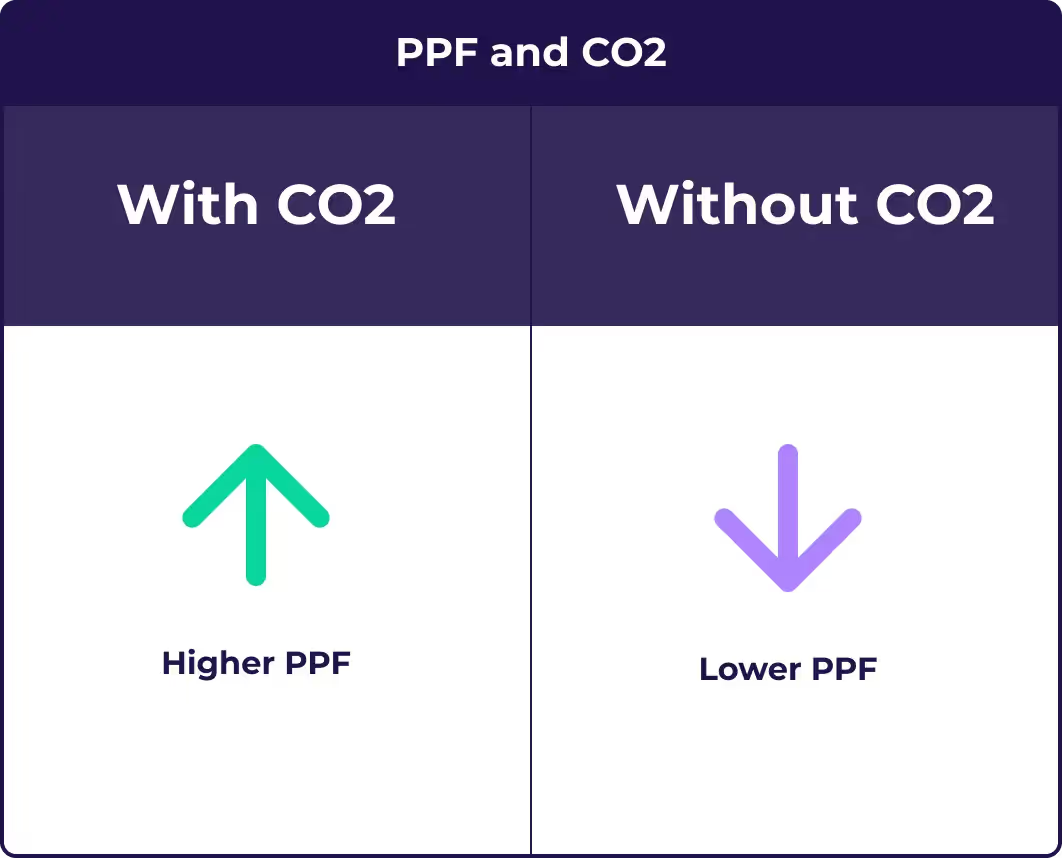Use the right PPFD chart for your style of growing


Using PPFD (Photosynthetic Photon Flux Density) charts can help you enhance plant health and yield.
This is true whether you're a beginner exploring indoor gardening or an experienced grower looking to refine your techniques.
In this article, we'll delve into the importance of PPFD charts for cannabis and explore why PPFD is particularly crucial for indoor growers growing under grow lights.
Additionally, we'll cover the difference between PPFD charts for growers who supplement with CO2 and those who don't. This differentiation is vital because CO2 supplementation significantly influences the optimal levels of PPFD needed for plant development.
So, whether you're seeking guidance on selecting the right PPFD chart for your indoor grow or aiming to enhance your understanding of light management, we’ve got you covered.
Disclaimer: Any information given on this site is for educational purposes only. Please ensure if you’re growing cannabis, you’re doing so in accordance with the law and subject to appropriate permissions and licenses of the applicable country.

Cannabis PPFD charts
Photosynthetic photon flux density charts for growing cannabis are invaluable tools for indoor growers, providing essential guidelines for optimising grow light output throughout the various stages of your plants’ growth.
But there are a couple of things to consider before you jump right in to start using one.
- Determine your CO2 supplementation status
The first step in selecting the right PPFD chart is determining whether you supplement your growing environment with carbon dioxide.
CO2 supplementation can significantly impact the grow light intensity requirements for your cannabis plants, so it's crucial to accurately assess your CO2 supplementation status before proceeding.
- Choosing the right PPFD chart
Once you've determined your CO2 supplementation status, you can select the appropriate PPFD chart for your grow environment.
If you don't supplement with CO2, choose a PPFD chart designed for growers without CO2 supplementation. If you supplement with CO2, opt for a PPFD CO2 chart tailored to CO2-enriched environments.

Reading PPFD charts
Here’s how to read a PPFD chart:
- Identify your plants’ growth stage
PPFD charts for plants typically outline different stages of plant growth, such as seedlings/clones, vegetative stage, flowering phase, and late flowering/ripening.
- Find recommended PPFD ranges
Look for the recommended grow light PPFD ranges provided for each growth stage. These ranges indicate the ideal levels of light required for healthy plant development.
Implementing PPFD recommendations
Consider your specific setup and grow light source equipment. Choose the PPFD ranges that best match your available PPFD output and growing environment. Then, adjust grow light levels accordingly to match the PPFD guidelines for each stage of growth.
Next, monitor PPFD and adjust as needed. Monitor PPFD levels in your grow space using a PPFD meter and adjust your grow light setup accordingly to maintain optimal light intensity.
Regularly referring to the PPFD chart helps ensure that your plants receive the appropriate amount of light for healthy growth and maximised yields.
Why PPFD charts are essential for indoor growers
Indoor cannabis cultivation presents unique challenges compared to outdoor growing. Precise light management is crucial for success. Here's why PPFD charts are indispensable tools for indoor growers and how they can help you achieve optimal results in your grow space.
Precise light control
Unlike outdoor environments, where sunlight intensity varies throughout the day, indoor growers must rely on grow lights - artificial light to provide consistent light energy. This includes LED lights, HPS lights, blurple, fluorescent lights, or CFLs.
PPFD charts offer precise recommendations on grow light levels and how much light your plants need. Ensuring that your cannabis plants receive the right amount of photons for healthy growth and development.
Maximising yield and quality
In the confined space of an indoor grow room, every aspect of cultivation must be carefully managed to maximise the quantity and quality of the end product.
After dialling in your environmental parameters, you can fine-tune your grow lights setup based on the recommendations provided in the correct PPFD chart.
By following the guidelines outlined in PPFD charts, you can optimise light distribution within your grow space, providing more light or less where necessary.
This minimises wasted energy whilst ensuring that each plant receives adequate light for optimal photosynthesis and nutrient uptake rates.

CO2 supplementation considerations
For indoor growers supplementing their environment with CO2, understanding the interaction between CO2 levels and PPFD is essential.
PPFD charts provide separate recommendations for growers using CO2 supplementation, acknowledging the impact of elevated CO2 levels on plant metabolism and growth.
Following the appropriate PPFD chart for your CO2 supplementation setup, you can reap the rewards of enhanced photosynthetic activity and achieve superior yields
Before considering CO2 supplementation, though, it's essential to prioritise environmental control in your grow space.
This includes maintaining optimal temperature, humidity, VPD and airflow levels to create a stable and conducive growing environment for your cannabis plants.
Avoid potential issues
Inadequate or excessive light can lead to a range of problems in your grow space. From stunted growth and nutrient deficiencies to decreased yield.
PPFD charts help you avoid these issues by providing scientifically backed recommendations for optimal levels of light at each stage of growth.
Adaptability to different setups
Whether you're working with a small grow tent or a large-scale indoor facility, PPFD charts can be tailored to suit your specific grow lights setup.
By understanding your growing environment's unique characteristics and following the corresponding PPFD recommendations, you can create an ideal growing environment that improves the potential of your cannabis plants.
Enhancing professional grower results
For professional growers with advanced cultivation setups, following PPFD recommendations can lead to significant gains in plant health, yield, and quality.
By meticulously monitoring and adjusting light levels throughout the growth cycle, professional growers can push their cannabis plants to their full potential and achieve exceptional results.
Unlock premium growing secrets – join the Grow The Best newsletter!

Risks of applying the wrong PPFD for your specific situation
Using an incorrect PPFD value from a chart that doesn’t reflect how you are or aren’t using CO2 can lead to various potential issues. Including compromised plant health and diminished overall yield.
Here are some risks associated with using the wrong PPFD chart (and PPFD values) and the impact they can have on your growing space.
Stunted growth
Stunted growth is one of the most common problems resulting from improper light intensity from your grow lights.
If your cannabis plants don’t get enough light due to following the wrong type of PPFD chart, they may struggle to photosynthesise effectively, leading to slow growth and underdeveloped foliage.
Nutrient deficiencies
Inadequate light can also disrupt nutrient uptake in plants, increasing the risk of nutrient deficiencies.
Without sufficient photons to drive photosynthesis from your grow lights, your plants may become deficient in essential nutrients such as nitrogen, phosphorus, and potassium, resulting in discoloured leaves, stunted growth, and overall poor health.
Decreased yield
Using the wrong type of PPFD chart can significantly impact your cannabis crop's yield potential.
Insufficient plant lighting can lead to reduced flower production and smaller, less potent buds, ultimately diminishing the overall harvest yield.
The reverse, excessive light intensity, from following a PPFD chart for CO2 supplementation, can also result in decreased yield due to stress-induced flower abortion and reduced resin production.
Quality issues
In addition to affecting yield, improper grow light use can also compromise the quality of your cannabis buds.
Insufficient light may result in airy, less dense buds with lower cannabinoid and terpene content, while excessive light can lead to harsher-tasting buds with decreased potency and aroma.
Wasted resources
Following the wrong PPFD chart jeopardises plant health and yield while wasting valuable resources such as electricity and grow space.
Inefficient grow light practices resulting from inaccurate PPFD recommendations can drive up energy costs and reduce the overall efficiency of your indoor cultivation operation.
Using the correct PPFD chart tailored to your specific grow environment and cultivation practices, you can avoid these pitfalls and ensure optimal plant health.

Optimal photosynthetic photon flux density for cannabis plant growth stages
How much PPFD for seedlings?
- Without CO2 supplementation: 100-250 µmol/m²/s
- With CO2 supplementation: 150-300 µmol/m²/s
- During the delicate early stages of growth, seedling stage plants and clones require gentle yet sufficient light to foster healthy development. PPFD charts recommend slightly lower PPFD levels to avoid stressing these young plants or causing light burn while still providing the necessary photons for photosynthesis.
How much PPFD for veg?
- Without CO2 supplementation: 200-400 µmol/m²/s
- With CO2 supplementation: 300-600 µmol/m²/s
- As your plants transition into the vegetative phase, they require an increase in the intensity of light to support robust foliage and stem growth. PPFD charts outline the ideal PPFD levels for the vegetative stage, ensuring your plants respond to optimal photosynthetic activity and produce lush, vibrant vegetative growth.
How much PPFD for flowering?
- Without CO2 supplementation: 400-600 µmol/m²/s
- With CO2 supplementation: 600-900+ µmol/m²/s
- When your plants enter the flowering phase, they demand more intense light to fuel the production of dense, resinous buds. PPFD charts specify the optimal PPFD levels required in the flowering stage to promote vigorous flowering and maximise bud development, helping you achieve bountiful harvests.
Late flowering/ripening:
- Without CO2 supplementation: 300-500 µmol/m²/s
- With CO2 supplementation: 500-800 µmol/m²/s
- In the final weeks of the flowering stage, adjustments to lighting may be necessary to facilitate ripening and enhance bud quality. PPFD charts provide guidance on fine-tuning PPFD levels during this crucial phase, allowing you to achieve optimal ripening and harvest your cannabis plants at peak potency.
These recommended PPFD levels provide a guideline for achieving optimal grow light levels at each growth stage, ensuring healthy development and maximised yield.
Adjustments within these ranges may be necessary based on specific environmental factors, and your grow lights and individual plant requirements.

The Grow Sensor - Boost your grow with our PPFD meter
The PPFD meter in the Grow Sensor is a game-changer when it comes to measuring light intensity and managing the light source in your grow space.
The Grow Sensor also features a full light spectrum quantum photosynthetic active radiation (PAR) sensor.
Hang the Grow Sensor light meter directly under your grow lights to measure useful light particles and PPFD output.
Designed for versatility, you can use our unique hanging system or mount it on a tripod to get accurate measurements.
This flexibility ensures precise positioning at the crop canopy level, where your plants interact with light sources for accurate light measurement.
As your plants grow, adjusting the height of your grow lights is vital for maintaining ideal PPFD levels at the plant canopy. Our ambient light meter makes this task easy.
By setting alerts in advance, you're promptly notified if your plants receive too much light or too little, allowing you to take action.
The Grow Sensor measures PPFD continuously in real-time, guiding your lighting strategy so that your plants thrive, not just survive.
Take control of your grow environment with our ambient light sensor, to grow better plants.

Takeaways:
Harnessing the power of PPFD charts is essential for indoor growers seeking to maximise their grow room success.
By understanding the specific light intensity requirements at each stage of plant growth right through from the seedling stage to ripening, you can optimise your grow lights’ setup and PPFD levels to promote healthy development, robust yields, and superior bud quality.
Whether you're a beginner or a seasoned professional looking to fine-tune your cultivation techniques, PPFD charts offer invaluable guidance for achieving ideal PPFD levels and optimal results in your grow space.
By selecting the appropriate PPFD chart based on your CO2 supplementation status and implementing its recommendations diligently, you can create ideal light and environmental conditions in your grow room to grow the best plants.
Remember, prioritising environmental monitoring and control should always come before CO2 supplementation.
By dialling in your grow space's light parameters according to PPFD recommendations and by measuring PPFD levels, you can lay the foundation for success and unlock the full potential of your plant’s growth.
So, whether you're aiming to boost yield, enhance quality, or simply maximise the efficiency of your indoor grow, let PPFD charts be a guiding light.
By tailoring your lighting setup to match the specific needs of your plants at each stage of growth, you can optimise plant health, yield, and quality, ultimately elevating your cultivation efforts to new heights.
Happy growing!
FAQs
Is PPFD the same as PAR?
No, PPFD is not the same as PAR (Photosynthetically Active Radiation). While PAR refers to the range of light wavelengths (400-700 nanometers) that plants use for photosynthesis, PPFD specifically measures the intensity of light within that range that reaches a specific area per unit of time. In essence, PPFD quantifies the amount of usable light available to plants for photosynthesis, whereas PAR encompasses the entire spectrum of light used by plants for this process.
How does Daily Light Integral relate to PPFD?
Daily Light Integral DLI and PPFD (Photosynthetic Photon Flux Density) are related in that DLI represents the total amount of PAR (photosynthetically active radiation) received by plants over 24 hours, while PPFD measures the intensity of light at a specific point in time.
In other words, PPFD gives you the instantaneous intensity of light at a given moment, typically measured in micromoles of photons per square meter per second (µmol/m²/s), while DLI provides a cumulative measure of light exposure over the entire day, measured in moles of photons per square meter per day (mol/m²/day).
PPFD helps growers assess the immediate intensity of light that plants receive, allowing them to adjust light fixtures and placement accordingly. DLI, on the other hand, gives growers an overall measure of how much light energy their plants receive over a day, which is crucial for understanding and optimising your plants’ growth and development.
In summary, while PPFD measures the instantaneous intensity of light, DLI provides a more comprehensive view of light exposure over time, making both metrics necessary for effective cannabis cultivation.
Do plants prefer blue light or red light?
Plants use both blue and red light for photosynthesis, but their preferences can vary depending on the stage of growth.
During the vegetative stage, plants tend to favour blue light, as it stimulates robust leafy growth and helps maintain compact, bushy plants. During the flowering stage, plants prefer red light, which promotes flower formation and enhances overall flower development.
However, it's important to note that plants require a balanced spectrum of both blue and red light, along with other wavelengths, to support healthy growth and development throughout their entire lifecycle.
Join the Grow The Best newsletter for top growing tips and tricks!











.avif)








